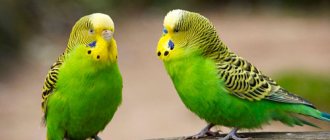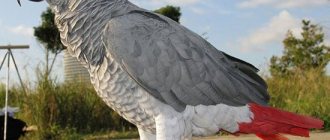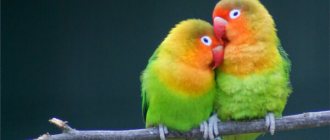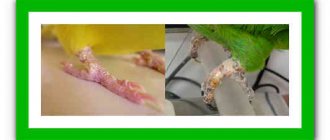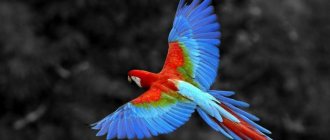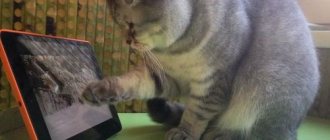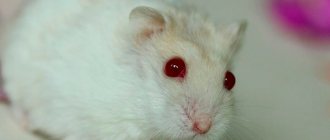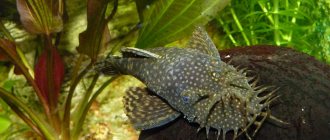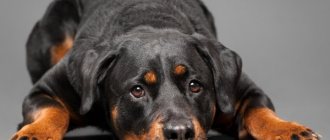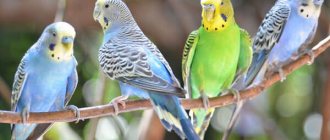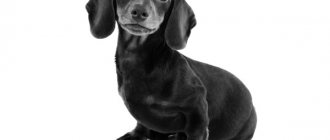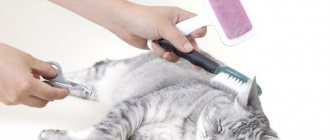Who are budgies?
Budgerigars are birds belonging to the parrot family, order Psittaciniformes. Birds of this species are the only ones of their genus “Melopsittacus”.
Characteristics of the type:
| Body length | From 17 to 19 cm |
| Individual weight | 45 gr. |
| Wings | Length – 10 cm. Necessary only for flight, unsuitable as a support when walking or in a sitting position. |
| Tail | Length – 10 cm. The older the bird, the longer the tail. |
| Beak | Curved and very strong. It can be used to hold onto branches or break up hard food (nuts). The color of the wax, located above the beak, helps determine the sex of the bird. |
| Limbs | The bird has 2 legs, each with 4 toes. 2 look forward and the rest look back. |
| Eyes | All colors are available. |
Since the time they learned about these parrots, nothing new has been added to their life story.
Types of budgerigars
Due to the great interest in budgerigars among people, over 200 species have been obtained using breeding methods.
The most common varieties of them, photos of which are replete with the Internet:
- Normal – budgerigars of the normal green row.
- Greywing, Clearbody, Opaline Cinnamon, Fallow, Opaline, Pied, Saddleback, Cinnamon, Spangle – birds related to green and blue a row of budgies.
- Albino (Albinos).
- Lutino (Lutinos).
- Clearwings are whitewings and yellowwings.
- Crested (One of the crested species).
- Yellowface (Yellowfaces).
Rare species of budgerigars are:
- Rainbow (Rainbow).
- Anthracite (Anthracite).
- Slate (apse).
- Lacewing.
- Texas Clearbody.
Among all species there are mutations that are highly valued among ornithologists and ordinary amateurs:
- Blackface (Black-faced).
- Speckled.
- Half-hearted.
- Misty.
- Curly.
- Speckled.
- Faded.
- Brownwings. Not to be confused with Cinnamon. They differ from them in the not bright shade of the feather.
Sometimes attempts to bring out the original color of a parrot end in failure. This is how, for example, birds with curly plumage are obtained. Because of this mutation, the life of such individuals does not exceed 1 year. Their feathers are in constant growth, which significantly shortens the bird's life cycle.
Don't miss the most popular article in the section: Kamchatka on the map of Russia. What makes the peninsula unique, interesting facts, geography.
Colors of budgies
The natural color of the budgerigar, which nature gave him, is soft green, with a glossy tint. It covers the lower back of the bird's body, as well as the chest and belly. The mask of these parrots is yellow (not cloying), with black markings on the throat.
Budgerigars are in great demand in the pet world, despite the fact that they were originally wild birds.
The cheekbones are covered with purple stripes. A black wave covers the back, head and wings. The wings have black plumage, but their edges have a yellow edging. The feathers on the tail are colored deep blue.
Most of the modern colors of parrots appeared as a result of selection. In 1872, yellow feather color was first bred in Belgium. Every year the shades of feather color changed.
As a result, the following color varieties were obtained:
- Dark green. Parrots with this coloration have the brightest feather color. For the first time, the offspring of wavy birds with a dark green color were obtained in 1915 in France. The back, belly and chest are a rich green color. The mask is yellow in color, with black circles on the neck. The cheekbones are painted purple. The shade of the wings does not differ from the natural one. The tail feathers are the darkest of all.
- Sky blue. This color was first obtained in Belgium in 1878. The bird's mask is white, and the lower back is sky blue. The undulation is very noticeable on the white plumage. The tail is blue, and the large leading feathers are black with a snow-white border.
- Olive green. Parrots with olive green feathers were first born in 1919 in France. The birds have olive green colored feathers with a very bright yellow mask. The undulations really stand out against the yellow background. The tail feathers are a richer color than those of the dark green species. The wings are green.
- Cobalt. In 1910, in the English city of London, budgerigars with cobalt plumage were shown at an exhibition. The feathers of the belly, back and breast, as well as the tail, are blue. The parrot's mask is snow-white. Thanks to this, the waviness is clearly visible. The color of the wings is blue and black. The tail feathers have a more saturated color compared to sky blue parrots.
- Gray. Gray-colored budgies were first introduced to the public in 1943 in two places: England and the Republic of Austria. Birds of this species have a gray feather color on the lower body and back, and cheekbones. The mask is painted white, and there are black dots on the neck. The wings also have a dark tint.
- Lilac. Parrots with this color have a rich lilac color without any admixture of gray.
- Gray-green . In 1935, as a result of the painstaking work of breeders, gray-green parrots were bred from Austria. The lower part of the body and keel of the bird, as well as its lower back, have a light mustard or greenish and gray tint. The mask is an expressive yellow color with black markings on the neck. Cheekbones are grey. The undulation is very clearly visible on the yellow plan. The flight feathers and tail feathers are black. The latter have a light yellow border around the edge.
- Violet . In 1928, in the Federal Republic of Germany (Germany), the first offspring of parrots with purple feathers were obtained. The lower back, keel and belly are colored deep purple. The birds' mask is snow-white, with black circles on the neck. The tail part of the parrot has a dark purple color, and the main flight feathers are black with a small white border along the edge.
- Lutinos. Parrots with this coloration have red eyes. Their feathers are bright yellow. Parrots' cheekbones have a pearlescent tint. The wings and tail are usually light. The paws of parrots are bright pink or brown-red.
- Albinos. In 1932 in Germany, this color in parrots was obtained by two amateur breeders at once. The feather color of parrots is snow-white, and their eyes are red.
- Mauve. Budgerigars (photos with this color are the most memorable) with this feather color were bred in 1920. The feathers have a rich gray-purple color. The bird's entire body is a delicate lilac-pink color. There are no inclusions or any stains. Under the beak there is a white mask with black dots. White feathers are also located on the forehead. Closer to the back of the head they begin to alternate with black ones.
The color of budgies depends on the amount of dyes contained in the feather structure. The outer part of the feathers has a colorless stratum corneum. It may contain lipochromes - substances with a yellow color.
Even deeper in the structure of the feather there is the same layer, but with transparent cells. On a dark texture they are perceived as blue or blue, and on a white texture they are snow-white. At the very core of the feather structure there are pigments, scientifically known as melanins, which can be black or brownish. Based on the calibration of all the above colors, the color of the budgie depends.
For example, if there are no melanins and lipochromes in the feather cells of a bird, then the parrot will be white. And if melanins are present in the core of the feather, but there are no lipochromes in the stratum corneum, then the feathers will be blue or light blue.
If the amount of melanin is high, then the color will be more saturated. If there are melanins and lipochromes in the plumage structure, the color of the bird will be green. If there is lipochrome in the stratum corneum, but no melanin, the parrot will have a yellow color.
Budgerigars, photos with colors that are not found in nature, were obtained as a result of many years of work by breeders. Based on knowledge of the structure of the feather, as well as relying on the laws of heredity, the familiar parrots with pinkish, gray and many other colors of feathers were bred.
Laws of inheritance on which the color of a budgie depends:
- When mating, representatives of the blue and green series produce offspring with brighter and cleaner plumage.
- Mating a cinnamon-colored parakeet and a plain-colored bird produces chicks that have delicate plumage with a brighter base.
- If during mating one of the birds has an opaline color and the other is normal, then the offspring will have a wider mask and beads on the neck.
Modern colors of budgies are the result of the work of breeders from all over the world.
Rare colors and mutations of budgies
Crested
Crested budgies have a crest on their head. It can be in the form of a bunch, a circle or a semicircle. There are individuals that have random feather tufts on the back and wings.
Rainbow
Parrots with this mutation have an unusual combination of waves and shades that include very bright colors.
Saddlebacks
Budgerigars, which are classified in this category, have a large number of darkish-gray markings in the saddle area. At the same time, there are few of them on the bird’s head.
Thus, we have examined with you the main varieties of these exotic birds. Of course, there are many other species among budgerigars. Therefore, next I will show you what other types of these pets there are. To do this, I present to you beautiful images of budgerigars of a wide variety of shades and colors. The rarest species of these amazing birds will also be shown here. Enjoy viewing the photos I have presented below.
How do budgies sing and what sounds do they make?
Budgerigars (photos and videos of which are especially popular among children) begin to make their sounds with the first rays of the sun. From them you can find out whether there is danger nearby, the mood of the bird, whether it is hungry. These birds make their first chirp at 3 months. Initially, their number is small, but as they grow older, their “vocabulary” is replenished.
Male parrots are more vocal. In the wild, they are the ones who try to attract the attention of females during the mating season. The latter can only sing along or respond a little to the call.
The sounds of a budgie can be conveyed in its intonation:
- Painful sensations.
- Greetings.
- Hunger.
- Happy or sad emotions.
- Showing interest.
- Flirting.
The longer a parrot lives, the more sounds it remembers. Over time, his songs combine a huge number of memorized tunes. They are often very specific. For example, this could be the sound of a door slamming or a key grinding in the keyhole. Life under the protection of a person allows you to enrich the parrot’s singing repertoire.
In their natural habitat, budgies communicate with each other using a small set of sounds:
- Que.
- Chivik.
- Pee-tee.
- Kvya.
- Piiu.
- Cha-cha.
In captivity they can also be heard. Knowing what each sound means helps you figure out what the parrot wants to say. So, for example, the frequent sound “piu” denotes changes around you.
This could be a change in the location of the cage, a different tulle on the windows, a new piece of furniture. The new color of the owner's hair will not escape the parrot's attention either. If the bird is unhappy, a sharp “quack” sound can be heard from its beak.
The frequently repeated sound of “Cheevy” indicates that the parrot is busy with something forbidden. For example, he may spoil the wallpaper or try to get some item that interests him.
At the sound of “Cha,” the parrot lets its owner know that it wants to take a walk. Also, this sound indicates that the bird is in a good mood. Singing "Piti-Piti" means that the parrot is calling someone to communicate. These could be birds he saw outside the window or one of his family members. If this sound is pronounced by a parrot in a sharp form and very loudly, it means that he is dissatisfied with something.
If a parrot begins to chirp frequently, this may mean a request to feed or to remove some foreign object from the cage that is bothering it. This bird greets familiar people with the sounds of “Chak chwa”.
At 1-1.5 years old, male parrots can begin to produce singing melodies. This means that he is ready to mate, and therefore he needs to find a girlfriend. In general, parrots can sing without stopping for many hours in a row. In the evening they become less talkative, and therefore the volume of the sounds they make becomes less.
Dating nuances
As soon as a second pet is purchased, it needs to be kept in a separate cage for some time to undergo quarantine, and it lasts about a month. Such actions help prevent infection with any infectious disease.
Dating rules include:
- Initially, cages with parrots are installed next to each other so that they can see and hear each other;
- then you can let them fly around the room for a short time, but if they start to fight or quarrel, you will have to keep them in different rooms again;
- if the second acquaintance goes poorly, then a new parrot must be replaced;
- during the adaptation period, birds should not be frightened, so they are kept in a quiet and calm environment;
- if breeding is planned, then the pets are kept in one cage, so it should be quite large, and a nesting house should be installed inside;
- two drinkers and feeders are purchased, as well as many perches and toys to prevent fights.
If your parrot has lived alone for a long time, then the appearance of a pair is stressful for him, so you will have to prepare for difficult adaptation or even aggression on his part.
How do budgies talk?
Budgerigars, unfortunately the photo cannot convey their wonderful chirping, are considered very talkative birds. They can reproduce not only a number of sounds that are not typical for them in the wild. In captivity, they remember and pronounce many of the noises and melodies they hear. Human speech was no exception.
Living in freedom, parrots do not need human words. When observing them in the wild, human speech will not be heard from their beaks. But living in captivity, wavy animals easily make contact with the owner and reproduce his speech.
If the owner and the bird develop a trusting and friendly relationship, then the parrot, as an interested party, begins to try to get closer to the person. He adopts words and phrases. He can repeat them meaninglessly, but quite legibly.
This type of parrot is very sociable. Therefore, they cannot imagine their life alone. If the bird lives alone in a cage, then its learning of human speech will be more successful, because the parrot itself will be interested in establishing contact with the person. But if the parrot is not alone in the cage, then it will be enough for him to communicate with a neighbor rather than with the owner.
What do budgies eat?
The diet of budgerigars in the wild is very varied, although the main food is small seeds of various land plants, so they are considered granivorous birds. But they do not refuse berries, nectar, flowers, juice and ripe pulp of fruits, flowers, leaves and young shoots of plants.
These birds easily adapt to the ripening of plants in certain seasons and during such periods they migrate to the places where they grow. They do not eat insects or tree seeds. Even seeds prefer a certain size, no more than 2.5 mm in length and weighing up to 1.5 mg. Moreover, before swallowing, they peel the husks from the seeds because these are mature and hard seeds. Moreover, before swallowing, the seeds are collected in the crop. During breeding, parrots try to eat not fully ripened, soft seeds. During these periods they prefer kangaroo grass seeds.
During feeding, huge flocks of birds, often several thousand in number, gather in the meadows. As soon as a few budgerigars land on the meadow and settle down to feed, clouds of relatives flying past join them, increasing the number of the flock several times. They run in crowds along the ground, collecting grains, constantly changing places, taking off and landing on plant stems. Flying from place to place, looking for new places rich in food, and the rest of the mass of birds moves behind them.
For several hours they are busy feeding, still keeping a short distance.
After feeding, the parrots always fly to the watering hole. One parrot does not drink that much, but the entire flock needs quite a large amount of water. A colony of thousands of parrots needs a body of water where a large number of them can quench their thirst at the same time. When the time comes for watering, flocks of hundreds, and sometimes thousands of parrots noisily descend to the river and scurry over the water, trying to quickly quench their thirst.
The haste of budgies at a watering hole is associated not only with the thirst that they experience after a hearty meal, but also because at a watering hole they can often be expected by enemies of whom they have many. These are predatory falcons, hawks and kites that guard them on approach in the water and attack flocks of parrots right in the air. Even crows often covet these harmless birds.
During the rainy season in Australia, thousands of tons of water fall to the ground, deep rivers and streams flow everywhere, lakes are filled to the brim with water, there is plenty of water around and there are no problems with watering. But in summer, in Australia's hot and dry climate, temperatures often exceed 40 degrees and there is no rain for several months. Small rivers and streams dry up, there is a catastrophic shortage of water and birds have to fly many kilometers away to drink. Therefore, they try to nest near large rivers or lakes. But during periods of prolonged drought, flocks of budgerigars sometimes have to migrate hundreds of kilometers, flying several tens of kilometers a day. During such flights, many birds, especially young ones, cannot stand it, fall behind the flock and die from thirst and hunger. But those who get to the water drink it copiously and swim in order to somehow maintain their water balance.
Some drink water from the edge of the shore, but most dive towards the water and, without stopping, grab the water in mid-flight. Thanks to their excellent flying abilities, budgerigars can stay in the air almost in place, like small helicopters, while descending to the surface of the water and swallowing water with their beaks. Often at such moments, some, more impudent ones, sit directly on the heads of their relatives without paying attention to it.
After a watering hole, in the midday heat, the flock settles down in the shade of trees. The noise and din subsides and it is time to rest. When the heat subsides, everyone goes out to feed again. Until the evening everyone is again busy looking for food.
At sunset, noise and hubbub from the piercing cries of budgies fill the surrounding area. This means they roost in bushes and trees for the night. Usually they do not have a permanent sleeping place and it happens that another flock tries to take away an already occupied place. At such moments, a real fight arises between the flocks, as a result of which one of the flocks is forced to look for another place to spend the night.
With the onset of night, silence sets in in the parrot colony until the morning, so that with the dawn of the sun this stormy and adventurous life begins again.
Interesting facts about budgies
Budgerigars have many interesting facts in their collection:
- The first description of this type of parrot was made in 1805 by Shaw, an English zoologist and botanist.
- The first owners of budgerigars were prisoners in Australia.
- In their homeland, Australia, budgerigars have lived for more than 5 million years.
- In the US state of Florida, there is a population of parrots that have flown away from their owners. The number of individuals in the flock is 8 thousand.
- A budgerigar nicknamed Puck has set a world record for the most spoken words. Their number is 1728 pieces.
- The vocabulary of the average budgie is between 100 and 150 units.
- The range of sounds of budgerigars is very wide. This gives them the opportunity to call their chicks with a certain sound. Children learn it and respond to it.
- Budgerigars, like people, are divided into right-handers and left-handers. It is quite easy to recognize this feature: which paw the bird takes food and uses most often is the leading one.
- These birds have average intelligence.
- The heart of a bird weighs less than 1 gram, but its heart rate reaches 200 beats per minute.
- The range of sounds they pronounce reaches 20 kHz. Some of them can be heard at a distance of 1 km or even more.
- Budgerigars are monogamous creatures.
- In captivity, parrots can live up to 20 years. In its natural habitat, the life cycle is much shorter - only a little over 6 years.
- Budgerigars love to sleep, and therefore spend up to 12 hours on it.
- The head rotation of budgerigars can be 180 degrees.
- During the mating season, males pretend to kiss the female. In fact, in this way they show their ability to take care of future offspring. And these kisses are just an imitation of the process of feeding the chicks.
- Budgerigar chicks are born without feathers and blind. Within 1 month they gain enough strength to leave their native nest.
Budgerigars, although originally wild birds, are very friendly to humans. They can become a good friend who can cheer you up and make you laugh with their pranks. Photos of their different colors allow you to see firsthand how beautiful and colorful these unique birds can be.
Article design: Mila Friedan
